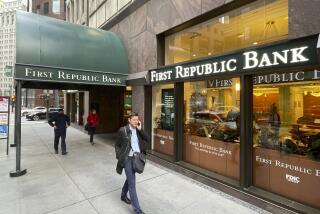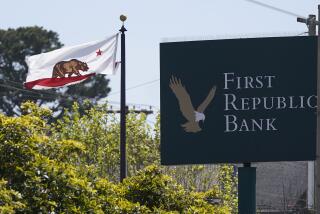Capital infusion plan is promising but not perfect
- Share via
WASHINGTON — The Bush administration’s sweeping new plan to pump $250 billion directly into U.S. banks promises to be a faster, easier, simpler and more direct way to revive the nation’s prostrate financial system, but it also sets the stage for a political tug of war that could persist long after the current crisis has passed.
Buying direct stakes in nine major banks, with potentially thousands more smaller and medium-size banks to come, was almost universally hailed. Democrats and Republicans stumbled over each other to claim credit for the idea, which was added almost as an afterthought to the $700-billion economic rescue legislation signed into law this month.
Senate Banking Committee Chairman Christopher J. Dodd (D-Conn.) quoted Treasury Secretary Henry M. Paulson as telling him, “Thank God” that the authority was included. And House Minority Whip Roy Blunt (R-Mo.) said House Republicans had insisted on the provision, adding, “It’s a national investment in these banks but it’s nowhere close to the nationalization effort in Europe.”
But the largest government intervention in the U.S. financial system since the Great Depression -- including a significant new expansion of federal deposit insurance -- plunges the federal government into areas it has seldom if ever ventured.
Paulson made a point of saying the government expects banks to lend the money they get from the government, not hoard it. But the plan has no specific requirements of them to do so.
The federal government also has no voting rights in the institutions it puts money into and little say in the banks’ future policies and investment decisions.
Even in the first wave of enthusiasm for the overall plan, that feature struck sparks. Sen. Bill Nelson (D-Fla.) said stock in the banks should come with voting rights. Barry Eichengreen, an economics and political science professor at UC Berkeley, agreed:
“The presumption is that we don’t want government bureaucrats interfering with the banks’ commercial decisions,” he said. “My view, to the contrary, is that we need to protect the taxpayer.”
The receiving banks will be subject to all the existing federal supervision and transparency requirements -- including bank examiners’ access to balance sheets and other records -- that existed before. And new regulations will be added, including the oversight provisions of the original bailout bill.
The strings that are attached to the federal money in the form of new Treasury Department rules are likely to raise questions and create friction, especially as time passes. New requirements on executive compensation, which will apply as long as the department holds a stake in a firm, prohibit incentives for “excessive” risk-taking and repayment of any bonuses based on financial reporting that is later shown to be “materially inaccurate.”
So-called golden parachute bonuses paid to departing executives are also prohibited, and only the first $500,000 of income to top executives will be tax deductible for a firm.
As Bush administration officials described the plan, it is designed to thread a narrow course, intervening decisively enough to get the financial engines working again but stopping short of intruding into the management of individual financial institutions.
“Government owning a stake in any private U.S. company is objectionable to most Americans -- me included,” Paulson said. “Yet the alternative of leaving businesses and consumers without access to financing is totally unacceptable.”
The new bank investment plan represents the last piece in a three-pronged strategy for attacking the financial crisis, one led by the Treasury Department, one by the Federal Reserve and another by the Federal Deposit Insurance Corp.
While the Treasury moves to recapitalize banks, the Fed is focused on providing liquidity -- cash on hand -- for a wide variety of banks, financial institutions and corporations.
The FDIC’s job is to shore up confidence by insuring nearly all non-interest-bearing bank accounts as well as funds that banks lend to one another.
On recapitalization, the goal is to help healthy banks resume ordinary functions, not to shore up failing parts of the banking system.
“Our goal is to see a wide array of healthy institutions sell preferred shares to the Treasury, and raise additional private capital, so that they can make more loans to businesses and consumers across the nation,” Paulson explained as he unveiled the plan alongside the heads of the Fed and FDIC.
Institutions approved by federal regulators will be eligible for capital infusions in the form of the Treasury buying preferred, nonvoting shares in their companies. Those shares will be first in line for dividend payments, set at 5% for five years and increasing after that.
Government officials said buying preferred stock would maximize the chances of tax dollars being repaid.
The Treasury also intends to implement two additional programs: one designed to buy up the toxic mortgage-related derivatives now clogging balance sheets around the world, and another to create an orderly liquidation process for large institutions.
The goal is to avoid the kind of case-by-case bailouts or bankruptcies of giant institutions such as investment firm Lehman Bros. Holdings Inc., insurer American International Group Inc. and mortgage titans Fannie Mae and Freddie Mac.
For its part, the FDIC announced two new measures: first, a temporary insurance program for the funds that banks lend one another, known as senior unsecured debt, and second, a temporary expansion of insurance to cover the large transaction accounts that businesses use to make large payments such as payrolls.
The regular insurance program had already been expanded to cover accounts up to $250,000. In effect, the FDIC will now offer insurance for all bank deposits except for interest-bearing accounts larger than $250,000.
“The overwhelming majority of banks are strong, safe and sound,” FDIC Chairwoman Sheila Bair said. “But a lack of confidence is driving the current turmoil. And it is a lack of confidence that these guarantees are designed to address.”
One goal of the expanded program is to keep businesses from moving their large transaction accounts -- which are often larger than $250,000 -- from smaller banks to larger ones out of fear that the funds would not be recoverable in case of default. Such withdrawals have been a factor in some recent bank defaults.
Banks will be automatically covered by the new insurance program for the next 30 days.
The Federal Reserve has already opened the money spigot nearly as far as it can go, announcing in recent days that it would make an unlimited amount of cash available to financial institutions for short-term loans and buy up commercial paper later this month.
Together, the policies should thaw the frozen financial system, officials said. But implicit was the hint that they were not designed to prevent the failure of unhealthy firms.
--
More to Read
Sign up for Essential California
The most important California stories and recommendations in your inbox every morning.
You may occasionally receive promotional content from the Los Angeles Times.











